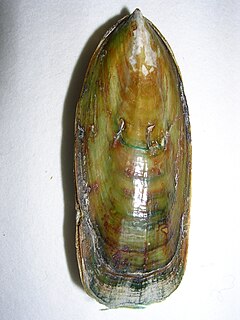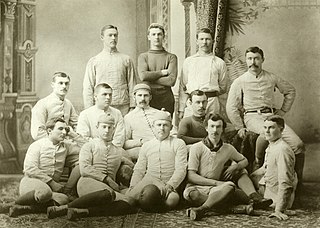
The Sapygidae are a family of solitary kleptoparasitic aculeate wasps. They are generally black wasps, similar in appearance to some Tiphiidae or Thynnidae, with white or yellow markings developed to various degrees.

Lingula is a genus of brachiopods within the class Lingulata. Lingula or forms very close in appearance have existed possibly since the Cambrian. Like its relatives, it has two unadorned organo-phosphatic valves and a long fleshy stalk. Lingula lives in burrows in barren sandy coastal seafloor and feeds by filtering detritus from the water. It can be detected by a short row of three openings through which it takes in water (sides) and expels it again (middle).
The 1882 Michigan Wolverines football team represented the University of Michigan in the 1882 college football season. The team played no outside games. The captain of the 1882 team was William J. Olcott.

The 1883 Michigan Wolverines football team represented the University of Michigan in the 1883 college football season. The Wolverines played their only home game at the Ann Arbor Fairgrounds.

David I. "Dave" Bitner was an American Republican politician from Florida. He served in the Florida House of Representatives. He was first elected to the Florida House in 1992.

Argyrotheca is a genus of very small to minute lampshells. All species share a large pedicel opening, one ridge on the inside of the pedunculate valve, pits in a diamond pattern on the inside of both valves, and without radial ridges that end in tubercles. It occurs in depths between 6 and 1300 m. It is known since the latest Cretaceous.
The following is a taxonomy of the Brachiopoda by Emig, Bitner & Álvarez (2019). There are over 400 living species and over 120 living genera of brachiopods classified within 3 classes and 5 orders, listed below.

Gwynia is a genus of very small to minute brachiopods.
Basiliola is a genus of brachiopods belonging to the family Basiliolidae.
Aulites is a genus of brachiopods belonging to the family Cryptoporidae.
Septicollarina is a genus of brachiopods belonging to the family Aulacothyropsidae.
Xenobrochus is a genus of brachiopods belonging to the family Dyscoliidae.
Simpliciforma is a monotypic genus of brachiopods belonging to the order Terebratulida, family unassigned. The only species is Simpliciforma profunda.
Oceanithyris is a monotypic genus of brachiopods belonging to the family Dyscoliidae. The only species is Oceanithyris juveniformis.
Nipponithyris is a genus of brachiopods belonging to the family Dallinidae.
Megerella is a monotypic genus of brachiopods belonging to the family Kraussinidae. The only species is Megerella hilleri.
Annuloplatidia is a genus of brachiopods belonging to the family Platidiidae.
Acrobrochus is a genus of brachiopods belonging to the family Terebratellidae.
Cryptopora is a genus of brachiopods belonging to the family Cryptoporidae.





